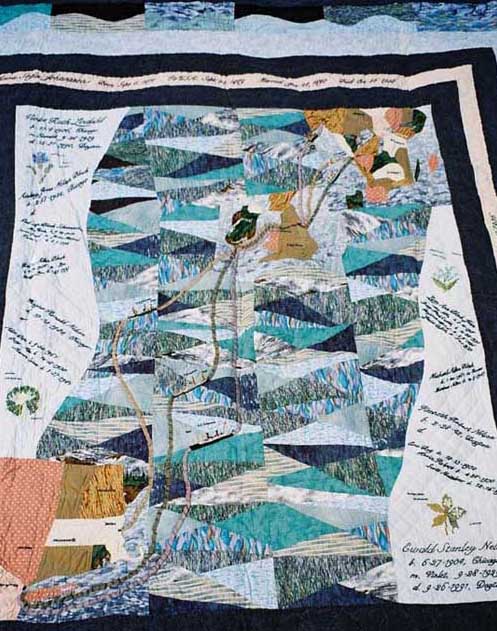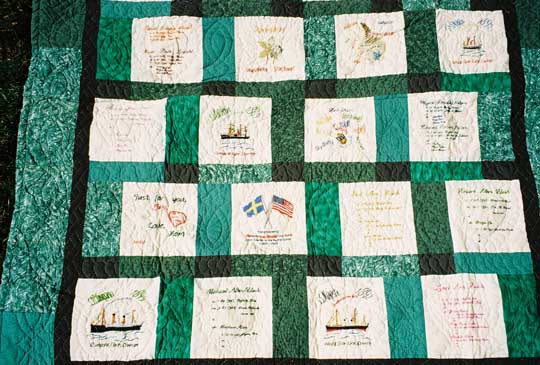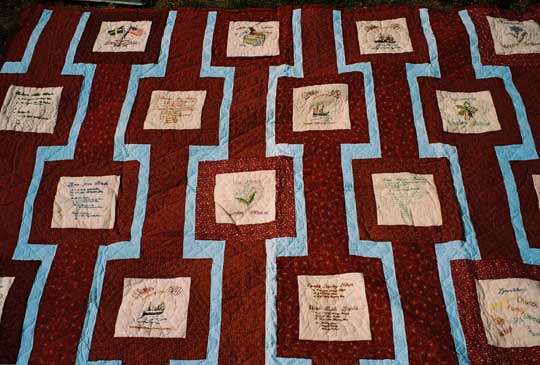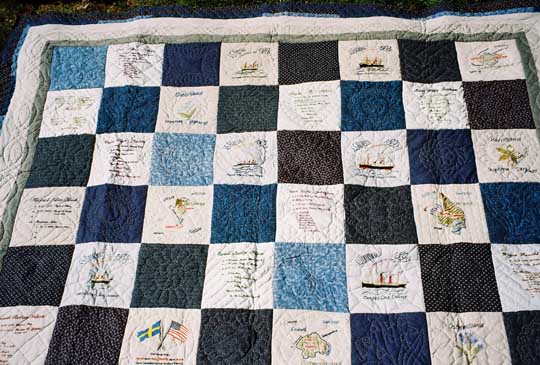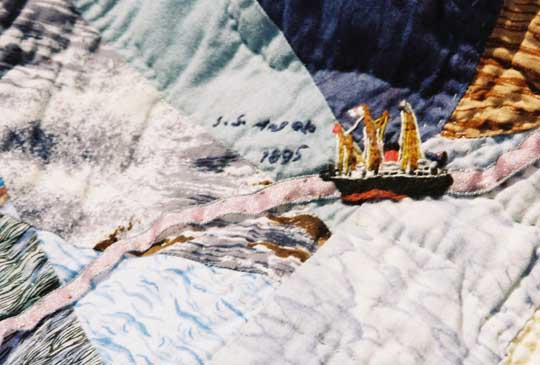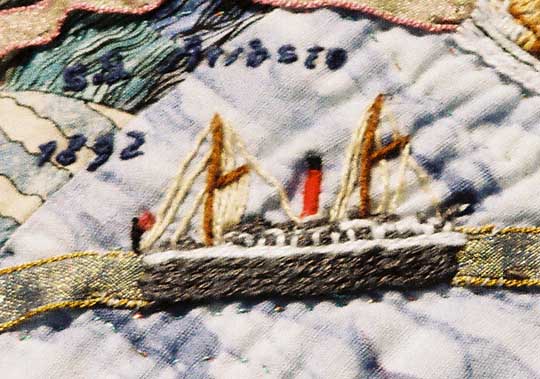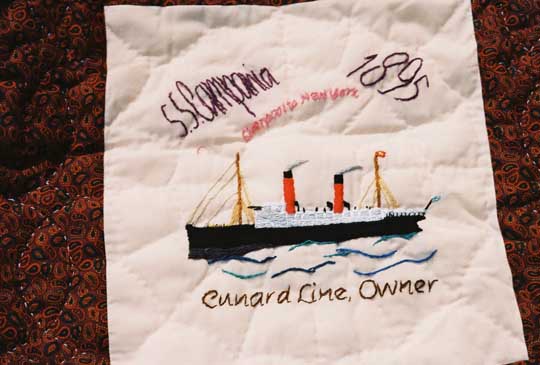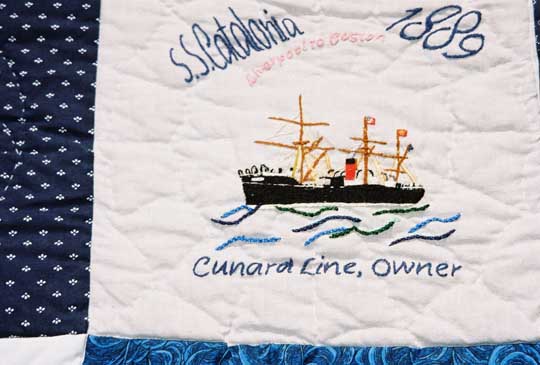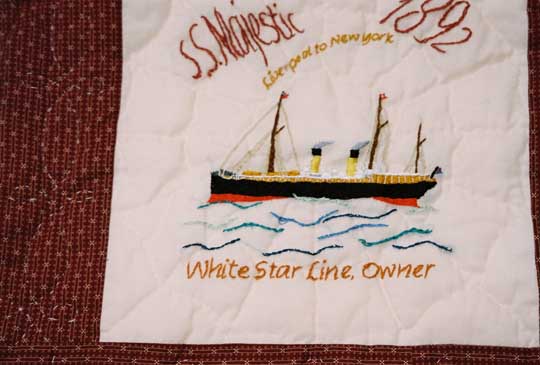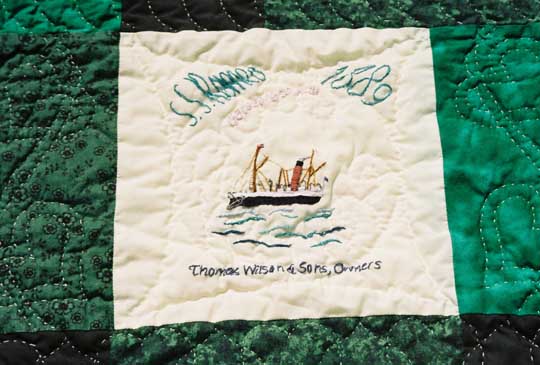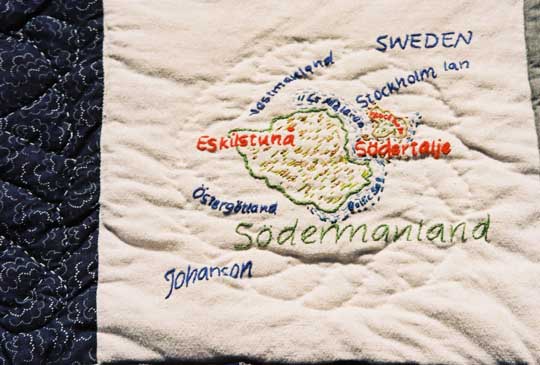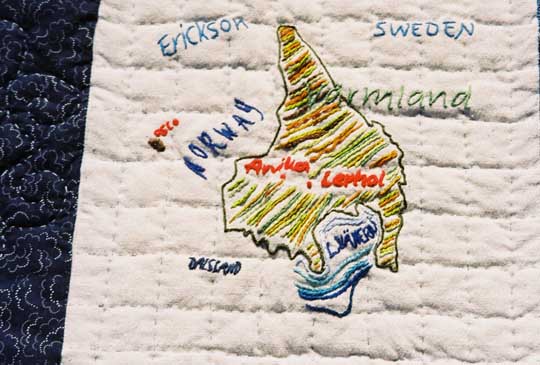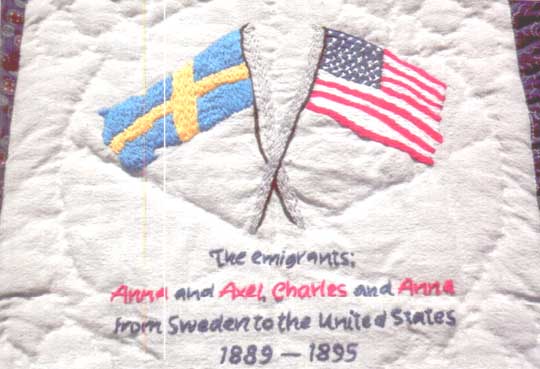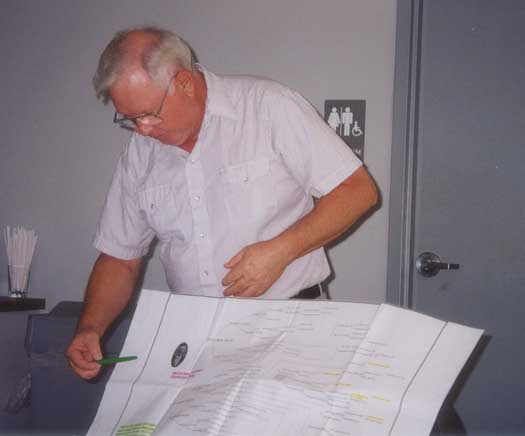|
GENEALOGY QUILTS
Many people look into their genealogy and gather reams of information like
birth, marriage, and death dates and places, immigration stories, occupations,
military service, residences through the years, health/cause of death, etc.
This information is often presented in charts, family trees, and books with
pictures and copies of pertinent documents. Audrey Black took a different
approach that combined her interest in genealogy with her skills in embroidery
and quilting.
Audrey has four children and eventually she gathered the genealogy
information, designed, pieced and quilted one unique “emigration quilt” for each
of them. The first went to Gail, her oldest child. The other three
got to choose their favorite colors. Audrey did all the embroidery work by hand
not using an embroidery machine.
Following in this Ponogram you will see the four quilts, with enlargements
of six ships, two Swedish “counties” and the crossed flags of the United States
and Sweden. Click your mouse on a picture to go to a higher resolution
file online which you can zoom in on (+) for a closer look, then use the left
arrow (←) to get back to the Ponogram. Be aware it takes the computer a bit
longer to work with high resolution graphics than text documents - patience is a
virtue.
GAIL’S QUILT
In the center "picture" area of Gail's quilt, Audrey traced the
emigration of her four grandparents from Sweden -- upper right corner -- to
Ireland/England in the upper middle, to Amerika -- the Boston/New York area
-- in the lower left corner. The upper left corner and left side and the lower
right corner and right side of the center "picture" contain the names and dates
of her parents, siblings and the grandchildren. The center "river of blue"
represents the Atlantic Ocean where the ribbons trace each emigrant's route from
Sweden to America. Each ribbon contains a depiction of the ship, with its
name and sailing date embroidered for identification.
Surrounding the central "picture" are 6 borders.
1. Dark blue quilted with interlocking hearts -- a separator.
BOB’S QUILT
Bob's quilt is a modified checkerboard layout; all
the genealogy information is on here as it is on Gail's quilt, just in squares,
not the geographic "picture". Using your mouse, click anywhere on the
picture to zoom in for a magnified look at the details. The quilt is
personalized with a square of Bob's interests in his life.
LYNN’S QUILT
All the genealogical information as well as all the ships, flowers and
läns are embroidered on this Emigrant Quilt just as it is on the others.
Also included is a square that tells of Lynn's 'likes' and interests.
After Audrey had all the salmon squares embroidered, the maroon ready for
framing the squares, Lynn asked if some blue could be added; some was, here is
the result.
This was the last quilt Audrey made of the four and it didn't take as long
to finish. The research was done, the printing on the computer was used
again, the carbon paper held up for one more transfer to the quilt, the
embroidery went faster, and the quilting went faster. As she describes it,
it seems Audrey's brain knew what to do, automatically.
MIKE’S QUILT
The läns, ships, provincial flowers for Värmland,
Östergötland and Dalsland are embroidered on this quilt for Mike. All the
same genealogical information is repeated here going back one more generation.
For Mike that would make it his great-great grandparents; see the block in the
upper left corner, second row. There is a block of Mike's interests in his
quilt also.
SHIPS
The genealogy research was done in the 1990's and
there weren't many pictures of ships available online then. Audrey wrote
to the Maritime museums in England (Greenwich) and in the US (Baltimore), plus
several other places, however, these were the two that had pictures of the ships
she needed. One person in France had a picture of one ship that none of
the museums had. Finally, all the ship pictures were found. Then Audrey
wrote letters to the museums to get the correct colors for the funnels (smoke
stacks), and the flags with their designs and colors. The White Star line
has a white star on a red background. That wouldn't look good on a Cunard
Line ship. Each trip, in this time frame of 1889 - 1895 took 2 or 3 weeks.
The ticket, which cost 510 Kr (Swedish Krona) in 1892, included meals on board,
overnight housing in Hull, railroad fare across England to Liverpool, housing in
that city until the transatlantic ship sailed, and transportation costs (usually
rail) to the destination city which was Chicago for the Erickson's and C. H.
Nelson. The Lindahl's stayed a short time in Boston, then went on to
Brockton, MA, and eventually settled in Chicago.
S. S. ANGELO
The Angelo, a feeder steamship of the White Star Line, carried Audrey's
dad's mother, Anna, her brother, David, and their widowed mother Maria
Persdotter (Mrs. Erik Eriksson) to Hull from Oslo, Norway. The Eriksson
homestead near Arvika, Värmland, Sweden, was closer to Oslo than to Göteborg,
Sweden. Sweden ruled Norway until 1906, the Eriksson family didn't leave
from a different country they left from Christiana (Oslo), which was in the
territory called Norway, ruled by the King and Parliament of Sweden. In
USA, Maria became Mary and Persdotter became Erickson. In Sweden, women
maintained their own surnames, not changing to the husband's name when married.
Ship dimensions: 258' 8" long, 33' 6" wide (beam),
18' 2" deep,
Ship hull: 3 masts, 1 funnel, regular,
1 funnel very small and posterior.
S. S.
ARIOSTO
The Ariosto, a steamship of the Thomas Wilson Line, flying the British
flag, was the ship Audrey's dad's dad, Karl Nilsson, sailed on from Göteborg,
Sweden, to Hull, England, across the North Sea. These ships plying the
North Sea from the several Scandinavian ports were called 'Feeder Ships',
feeding the flood of emigrants to the ports of England, France, and Germany on
their way across the Atlantic to Canada, the US and even some South American
ports. This ship was built in1890 by Earle's Co., Hull, England.
Ship dimensions: Length- 300' 4", Breadth (Width)- 38'
0", Depth- 20' 0"
S. S.
CAMPANIA
The Campania, a steamship of the Cunard line, built 1893, sailed across
the Atlantic from Liverpool to NYC, Ellis Island Immigration Center, with the
Eriksson family on board: Anna, David and their mother, Maria, Audrey's great
grandmother. In 1897, Maria, sick, wanted to return 'home' to Sweden, she
and 2 of her sons, Emil and John (Johannes) sailed back getting as far as
Southampton, England where Mary died in an infirmary and is buried. The
return ship's name is unknown but might have been the St. Louis.
Campania dimensions: 601' long, 65' 2" beam
(width) 37' 8" feet deep.
Decks: Poop 75' long, forecastle 120', promenade deck 370'.
Hull: two funnels, two masts, tonnage of 12,950 gross tons, 10,267 under
deck and 4,974 net tons.
S. S.
CATALONIA
The Catalonia, a steamship in 1889, carried to
America from Liverpool, England, Audrey's maternal grandparents, Anna Johansson
and Axel Lindahl. The couple married in Brockton, MA, January 1890;
eventually having 5 boys and 2 girls; Violet, Audrey's mother was the youngest.
The ship was built in 1881 by J. & G. Thompson &
Co., Glasgow, Scotland for the Cunard Steam Ship Company, Limited.
Ship dimensions: 429' 5" Long 43'
Wide (Beam) 33' 7" Deep
Weight: 4,638 gross tons,
3,093 net tons,
Hull: Iron with 2 decks,
3 masts, one smoke stack.
S. S.
MAJESTIC
The Majestic, a steam ship of the White Star Line, carried Karl Nilsson to
America across the Atlantic from Liverpool, England. When Karl arrived in NYC he
decided to Americanize his name and chose Charles H. Nelson. 'C.H.' as he
was called, landed at Ellis Island in August 1892, the Immigration Center had
opened just 8 months before, January 1, 1892. An interesting note: When
the Titanic went down (1912) there were survivors with return tickets to
England. The Majestic was brought out of 'mothballs', sailed to NYC,
picked up these passengers, brought them back home to England, safely.
Ship dimensions: 565' 10" Length, 57' 10" Width
(Breadth), 39' 5" Depth.
Her engine: twin screw, overlapping. 1,875 nhp,
Coal burner- 5,000 tons.
Hull: Seimens-Martin Steel, 3 decks, 13 bulkheads. Duplicated
steering gear.
S. S.
ROMEO
The Romeo took a young couple, Anna Johansson, aged 18 years and 1 day,
and Axel (Dahl) Lindahl, 21, from Göteborg, Sweden to Hull, England, in 1889.
Axel was apprenticed to Anna's father, learning the shoemaking (cobbler) trade.
Interesting note: Anna and Axel, engaged, sailed on the Romeo, very romantic.
These ships were transitioning from sail to steam. Steam was faster but
more costly, wind was free for the sailing ships. Coal (to make steam) was
very expensive at this time -- the ships used both as the weather permitted and
the availability of coal permitted. Also coal was very heavy and the
weight could be put to better use to carry more paying passengers.
The Romeo, feeder ship, steam schooner, had 2 decks, one of iron, 3
bulkheads, 2 partial bulkheads, one funnel, and was built in 1881, by Earle's
Shipbuilding & Eng. Co., Ltd. of Hull, for Thomas Wilson & Sons Line, Hull,
England.
Ship dimensions: 275' Length, 34' 6" Width (Beam),
19' 9" Deep.
Decks: Poop 370 tons, forecastle 41 tons.
Rigging: iron construction, single screw, 2 masts
Tonnage: 1840 gross tons, 1376 under deck,
1210 net tons.
SWEDISH LÄN(s)
A län is a district roughly equivalent to one of our very large counties
in a big western state. In the US we would think of it as a 'state' but a
län is not the same politically. It doesn't have it's own Governor and
legislature, Secretary of State, Attorney General, Treasurer, Auditor, or Army
and Navy (the Reserves) that each of our 50 states have. That makes one
think of a län as more like one of our counties than one of our states.
Dalsland län in the southwest area of Sweden, along the shores of the
largest lake in Sweden, Lake Vänern, is the homeland of Charles H. Nelson.
His dad married twice, so Charles had 4 half siblings. His dad passed away
in 1890, Charles served his 2 years of compulsory military service in 1890-92,
then in 1892 left Sweden for the USA. He was a farmer in Sweden, picked up
a hammer in the US, becoming a carpenter and contractor, owning his own
business.
Östergötland län is in the central eastern area of Sweden, bordering on
the eastern shore of the smaller of the two large lakes, Vättern. Anna
Johansson's parents and seven siblings were well to do, her dad, Johan, a
successful shoemaker selling both wholesale and eventually retail. Anna is
the oldest of 8 children and in America worked as a laundress 'for the rich
people of Chicago' while raising 7 children. Axel Albert Dahl Lindahl, son
of August Persson Dahl (son of Peter) changed his name to Lindahl before coming
to USA. Axel was one of six children but none of the others changed their
names. Axel, a master shoemaker worked for Florsheim Shoe Company in the
US, learning the trade, in Sweden, from Anna's dad.
SÖDERMANLAND
Södermanland län, bordering along the Baltic Sea, is
just south of the capitol of Sweden, Stockholm. Anna's dad had a retail
store in Eskilstuna, Södermanland, selling his shoes and accessories. The
Johansson family lived there for a brief time.
VÄRMLAND
Värmland län in western Sweden, bordering with
Norway, was home to Anna Eriksson, her parents and four siblings for many
generations back. They were successful farmers. Anna was a
housewife, and volunteered at the Swedish Covenant church.
FLAGS
The flags are the same on all three quilts. Audrey wanted to show
the Emigrants' allegiance to their country of birth, Sweden, and their new
citizenship to their new country, the United States of America.
AFTERWORD
This P-gram is a summary of the topic. If you are interested in more
detail, go to the more extensive version on my
website.
I’d like to remind you that all previous Ponograms are online.
Please visit the homepage at
http://www.sandinfamily.com and choose “Ponograms” from the main menu.
Some of the online versions have enhancements and/or corrections made after
original email distribution.
|
